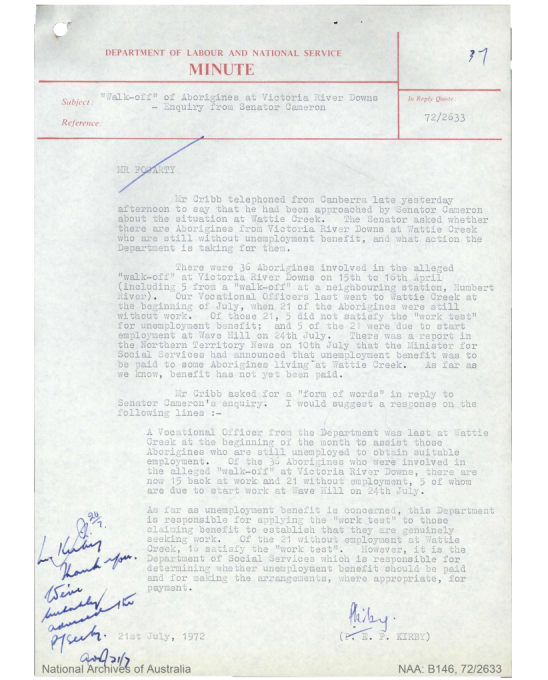
Workers involved in walk-off denied payments
Aboriginal workers walked off the Victoria River Downs cattle station in 1972 over pay and working conditions. The government was hesitant to pay Unemployment Benefit even though they passed the work test.
... the Minister for Social Services had announced that unemployment benefit was to be paid to some Aborigines living at Wattie Creek. As far as we know, benefit has not yet been paid.
| Attachment | Size |
|---|---|
| workers-walkoff-ueb-letters.pdf | 2.08 MB |
| Attachment | Size |
|---|---|
| workers-walkoff-ueb-letters-plaintext.docx | 47.74 KB |
In April 1972, 3 Ngarinyman stockmen led over 100 people to walk off the Victoria River Downs (VRD) cattle station in the Northern Territory. They travelled to Wattie Creek, more than 160 kilometres away.
There they joined Gurindji and Warlpiri people who had walked off the Wave Hill Station 6 years earlier. The walk-off and set-up of the community at Wattie Creek was part of a significant Aboriginal protest for equal wages and land rights.
This artefact shows government discussions about whether those at Wattie Creek were eligible for Unemployment Benefit.
Request for Unemployment Benefit
The workers at Wattie Creek believed they were eligible for Unemployment Benefit based on effectively being let go from their jobs.
This was because their employers would not offer legal wages and conditions to keep them at work. An article in the Tribune newspaper argued that Gurindji and Warlpiri workers were expected to ‘go back and work from daylight to dark for employers who will pay you substandard wages … or else fend for yourselves’ (Tribune 1966).
The ‘work test’ as a measure of eligibility
To be eligible for Unemployment Benefit, people had to pass the ‘work test’. To pass, people had to show they were actively looking for work.
The Department of Labour & National Service (L&NS) was responsible for administering the work test. They would then make a recommendation to the Department of Social Services (DSS), who would decide whether a person was eligible for the payment claimed.
In 1972, L&NS confirmed most of the VRD workers passed the work test. However, after some time L&NS officials found that the people at Wattie Creek who had met the conditions still hadn’t received government payments.
L&NS officials noted that in the media the Minister for Social Services William Wentworth had publicly said Unemployment Benefit would be paid to people at Wattie Creek who met the work test requirements (NT News 1972).
Denial of payments to eligible people
These excerpts from an L&NS file record a 1972 meeting in Darwin. The meeting was with Northern Territory representatives, Wentworth and DSS officials. They discussed the case of 36 VRD workers who had applied for Unemployment Benefit.
At the meeting, L&NS officials confirmed that applicants from Wattie Creek had met the work test, and that their reasons for leaving VRD were justified. Despite this, everyone at the meeting including L&NS officials, expressed resistance to granting Unemployment Benefit.
The minister was ‘reluctant’ for applicants to be considered eligible as he expected older men ‘would become permanent U.B. recipients’.
Recommendation to make a lesser payment
Northern Territory officials suggested that they could offer training positions, for which people would receive a Training Allowance payment. This was lower than Unemployment Benefit.
DSS said they could apply a policy to automatically reject applications for Unemployment Benefit from people who wouldn’t accept Training Allowance.
Moving Aboriginal people onto Training Allowance instead of Unemployment Benefit was a common DSS strategy at the time.
Improved access to payments and gradually higher wages slowly introduced cash into remote communities like Wattie Creek during this time. However, these excerpts show the government’s hesitancy to grant Unemployment Benefit to Aboriginal people in the Northern Territory.
Following the 1966 Wave Hill walk-off, Gurindji leaders travelled Australia to promote their protest for equal wages. Media coverage was sympathetic to the Gurindji cause, stressing the point that workers had essentially been ‘sacked’ and should therefore be eligible for Unemployment Benefit (The Tribune 1966).
This internal correspondence was kept in a file by the Department of Labour & National Service. The file was later transferred to the National Archives of Australia, which holds it as part of the national archival collection.
Access this correspondence in the file through the National Archives of Australia online catalogue RecordSearch. Go to pages 4, 8 and 14–15.
Permissions
This excerpt was selected to not include documents with the names of Aboriginal people as they could not all be identified to provide permission.
Consultation about the use of this source was undertaken with Traditional Owner Rob Roy of the Gurindji Aboriginal Corporation.
Citation
National Archives of Australia: Department of Labour and National Service; B146, Correspondence files, 1940–; 72/2633, Victoria River Downs Station NT – walkout of Aboriginal stockmen re wages and conditions, 1972.
